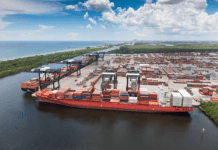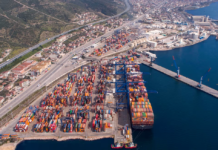
The Port of Long Beach has registered its second-highest September on record, demonstrating the need for extended working hours within the supply chain as unprecedented numbers of vessels wait off the US West Coast to unload cargo.
“We are having capacity issues due to the unprecedented number of containers waiting to move off the terminals, while warehouses have little to no room to accommodate this ongoing spike in cargo moving through our port,” explained Mario Cordero, Executive Director of the Port of Long Beach.
In the previous month, the Californian port moved a total container volume of 748,472TEU, representing a decline of almost 6% from the port’s strongest September on record, achieved in 2020.
In particular, imports decreased by 8.7% to 370,230TEU, while exports reached 110,787TEU, which translates to a slight downtrend of 1.6%. At the same time, empty containers moved through the port also dropped by 3.6% to 267,456TEU.
“This is not just about a record number of ships waiting off the coast. We are working with state, federal, local and industry partners to address issues with the entire supply chain that have finally caught up with us,” added Mario Cordero.
These supply chain bottlenecks that the San Pedro Bay ports are facing have led the Biden Administration to suggest the extension of the working hours to all-day operations amid the imminent holiday season.
Port of Los Angeles Executive Director Gene Seroka has welcomed Biden’s proposal, commenting, “The significance of the announcement is the commitment from industry leaders responsible for moving goods on behalf of American consumers and businesses to open up the capacity needed to deliver.”
He pointed out, “It’s a call to action for others to follow.”
Earlier in September, Long Beach’s Total Terminals International container terminal on Pier T launched a pilot program that makes it easier for trucks to access the facility during overnight hours.
“Issues within the supply chain have slowed the country’s economic momentum, but have not reversed it,” noted POLB. “Strong consumer spending supported by rising employment and wage growth will continue to drive economic expansion.”
“Our waterfront workforce is moving cargo as quickly as possible,” stated Long Beach Harbor Commission President Steven Neal, who went on to add that “this cargo surge is anticipated to last well into 2022, and so we need to start thinking of new ways to meet the expected growth in goods movement and rising consumer demand.”
Despite the current hardships, during the first nine months of the year, the Port of Long Beach has moved 7,094,849TEU, achieving a growth of 24.3% from the corresponding period in 2020.
Furthermore, the second-busiest port of the United States estimates to move more than 9 million TEU by the end of this year, surpassing the current record of 8.1 million TEU achieved in 2020.
Antonis Karamalegkos
Managing Editor
Vivi Dara
Editor





